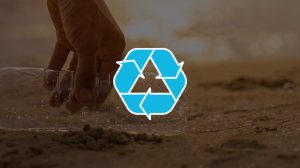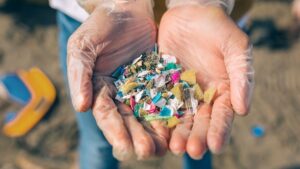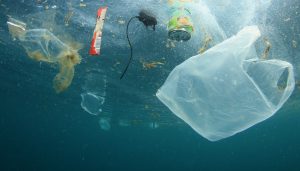A Strange New Blend of Rock and Plastic Is Forming on a Portuguese Island
In a paper published this month, researchers have identified a new, and perhaps more permanent type of plastic pollution that is incorporating itself directly onto the rocky shoreline of the Portuguese island of Madeira. The new blend of plastic and rock is dubbed “Plasticrust”.
Full Article
By Jake Buehler
If you go to the beach, you’re likely to see some form of plastic pollution scattered in the waves or sprinkled among the sand grains. A bottle cap fragment here, a transparent piece of packaging there. But researchers have identified a new, and perhaps more permanent type of plastic pollution, one that incorporates itself right into the rocky shoreline: “plasticrust,” a veneer of plastic encrusted right onto wave-licked rocks.
Ignacio Gestoso, a marine ecologist at the MARE-Marine and Environmental Research Center on the Portugese island of Madeira, first noticed the strange crusts on the volcanic island’s shoreline rocks in 2016. The light blue films were plastered onto the rock like old chewing gum grafted onto a sidewalk. Gestoso and his colleagues took some photos and quick samples, but figured the sighting was a one-off. The next year, the researchers saw that the crusts were still there. Early this year, they returned to the spot to find more area covered in the mysterious substance, now in multiple colors. So, the team decided to take measurements and collect more samples to see what they were dealing with.
By randomly sampling rocky areas of the shoreline, the researchers found that over three years, the crusts had gone from a single sighting to covering nearly 10 percent of the rocks’ surfaces. Chemical analysis of the stuff revealed that it was polyethylene, an extremely common plastic often used in single-use packaging and food containers.
In a paper published this month in the journal Science of The Total Environment, Gestoso and his team formally dubbed the phenomenon as “plasticrust,” a never-before-seen form of plastic pollution. Tragically, it’s not even the first type of totally new material our species has birthed into the natural environment with our plastic pollution. Six years ago, researchers found an unholy merger of plastic and rock on a Hawaiian beach, the result of campfires melting plastic waste and bonding it with sand and pebbles. But unlike this “plastiglomerate,” Gestoso thinks plasticrust was forged by water, not fire.
“[The crusts] likely originated by the crash of large pieces of plastic against the rocky shore, resulting in plastic crusting the rock in a similar way algae or lichens do,” Gestoso told Earther.
Plasticrust and plastiglomerate are sobering reminders of the unyielding permanence of plastic pollution. Plastics have become so ubiquitous on this planet that they—with other technological detritus and an overwhelming quantity of chicken remains—will likely generate an obvious fingerprint of humanity in the fossil record for many tens of millions of years. Long after our species is gone, these “technofossils” may remain in the strata: the Anthropocene’s collective, subterranean tombstone.
But plasticrust may have more immediate impacts. On Madeira, the plasticrust is gradually replacing natural biological crusts and films on the rocks—surfaces that intertidal animals like barnacles and snails adhere to and feed from. Gestoso’s team found that an algae-eating species of winkle sea snail was nearly as abundant on the plasticrusts as it was on normal surfaces, suggesting that the mollusks might not avoid plasticrusts, but graze on the algae that settle right on top. That raises the possibility that they’re ingesting some of the plastic in the process.
Read the full story at Earther.Gizmodo.com




